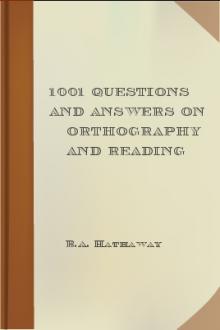Big Dummy's Guide To The Internet by Electronic Frontier Foundation (early reader chapter books .txt) 📕

- Author: Electronic Frontier Foundation
- Performer: 1428042873
Book online «Big Dummy's Guide To The Internet by Electronic Frontier Foundation (early reader chapter books .txt) 📕». Author Electronic Frontier Foundation
This particular “mail server” is run by Oregon State University.
Its main purpose is actually to provide a way to distribute agricultural
information via e-mail. If you’d like to find out how to use the
server’s full range of services, send a message to its address with this
line in it:
send help
You’ll quickly get back a lengthy document detailing just what’s
available and how to get it.
Feeling opinionated? Want to give the President of the United
States a piece of your mind? Send a message to president@whitehouse.gov.
Or if the vice president will do, write vice-president@whitehouse.gov.
The “mail” program is actually a very powerful one and a Netwide
standard, at least on Unix computers. But it can be hard to figure
out — you can type a question mark to get a list of commands, but
these may be of limited use unless you’re already familiar with Unix.
Fortunately, there are a couple of other mail programs that are easier
to use.
2.2 ELM — A BETTER WAY
Elm is a combination mailbox and letter-writing system that uses
menus to help you navigate through mail. Most Unix-based host systems
now have it online. To use it, type
elm
and hit enter. You’ll get a menu of your waiting mail, along with a
list of commands you can execute, that will look something like this:
Mailbox is ‘/usr/spool/mail/adamg’ with 38 messages [ELM 2.3 PL11]
1 Sep 1 Christopher Davis (13) here’s another message.
2 Sep 1 Christopher Davis (91) This is a message from Eudora
3 Aug 31 Rita Marie Rouvali (161) First Internet Hunt !!! (fwd)
4 Aug 31 Peter Scott/Manage (69) New File University of Londo
5 Aug 30 Peter Scott/Manage (64) New File X.500 service at A
6 Aug 30 Peter Scott/Manage (39) New File DATAPAC Informatio
7 Aug 28 Peter Scott/Manage (67) Proposed Usenet group for HYTELNET n
8 Aug 28 Peter Scott/Manage (56) New File JANET Public Acces
9 Aug 26 Helen Trillian Ros (15) Tuesday
10 Aug 26 Peter Scott/Manage (151) Update Oxford University OU
You can use any of the following commands by pressing the first character;
d)elete or u)ndelete mail, m)ail a message, r)eply or f)orward mail, q)uit
To read a message, press . j = move down, k = move up, ? = help
Each line shows the date you received the message, who sent it,
how many lines long the message is, and the message’s subject.
If you are using VT100 emulation, you can move up and down the
menu with your up and down arrow keys. Otherwise, type the line number
of the message you want to read or delete and hit enter.
When you read a message, it pauses every 24 lines, instead of
scrolling until it’s done. Hit the space bar to read the next page.
You can type a lowercase r to reply or a lower-case q or i
to get back to the menu (the I stands for “index”).
At the main menu, hitting a lowercase m followed by enter
will let you start a message. To delete a message, type a lower-case
d. You can do this while reading the message. Or, if you are in
the menu, move the cursor to the message’s line and then hit d.
When you’re done with elm, type a lower-case q. The program
will ask if you really want to delete the messages you marked. Then,
it will ask you if you want to move any messages you’ve read but
haven’t marked for deletion to a “received” file. For now, hit your n
key.
Elm has a major disadvantage for the beginner. The default text
editor it generally calls up when you hit your r or m key is often a
program called emacs. Unixoids swear by emacs, but everybody else almost
always finds it impossible. Unfortunately, you can’t always get away
from it (or vi, another text editor often found on Unix systems), so
later on we’ll talk about some basic commands that will keep you from
going totally nuts.
If you want to save a message to your own computer, hit s, either
within the message or with your cursor on the message entry in the elm
menu. A filename will pop up. If you do not like it, type a new name
(you won’t have to backspace). Hit enter, and the message will be saved
with that file name in your “home directory” on your host system. After
you exit elm, you can now download it (ask your system administrator for
specifics on how to download — and upload — such files).
2.3 PINE — AN EVEN BETTER WAY
Pine is based on elm but includes a number of improvements that
make it an ideal mail system for beginners. Like elm, pine starts
you with a menu. It also has an “address book” feature that is handy
for people with long or complex e-mail addresses. Hitting A at the
main menu puts you in the address book, where you can type in the
person’s first name (or nickname) followed by her address. Then, when
you want to send that person a message, you only have to type in her
first name or nickname, and pine automatically inserts her actual
address. The address book also lets you set up a mailing list. This
feature allows you to send the same message to a number of people at
once.
What really sets pine apart is its built-in text editor,
which looks and feels a lot more like word-processing programs
available for MS-DOS and Macintosh users. Not only does it have
word wrap (a revolutionary concept if ever there was one), it also has a
spell-checker and a search command. Best of all, all of the commands
you need are listed in a two-line mini-menu at the bottom of each
screen. The commands look like this:
^W Where is
The little caret is a synonym for the key marked “control” on your
keyboard. To find where a particular word is in your document, you’d
hit your control key and your W key at the same time, which would bring
up a prompt asking you for the word to look for.
Some of pine’s commands are a tad peculiar (control-V for “page
down” for example), which comes from being based on a variant of
emacs (which is utterly peculiar). But again, all of the commands you
need are listed on that two-line mini-menu, so it shouldn’t take you
more than a couple of seconds to find the right one.
To use pine, type
pine
at the command line and hit enter. It’s a relatively new program, so
some systems may not yet have it online. But it’s so easy to use, you
should probably send e-mail to your system administrator urging him to
get it!
2.4 SMILEYS
When you’re involved in an online discussion, you can’t see the
smiles or shrugs that the other person might make in a live
conversation to show he’s only kidding. But online, there’s no body
language. So what you might think is funny, somebody else might take as
an insult. To try to keep such misunderstandings from erupting into
bitter disputes, we have smileys. Tilt your head to the left and look at
the following sideways. :-). Or simply :). This is your basic “smiley.”
Use it to indicate people should not take that comment you just made as
seriously as they might otherwise. You make a smiley by typing a colon,
a hyphen and a right parenthetical bracket. Some people prefer using the
word “grin,” usually in this form:
Sometimes, though, you’ll see it as grin or even just for short.
Some other smileys include:
;-) Wink;
:-( Frown;
:-O Surprise;
8-) Wearing glasses;
=|:-)= Abe Lincoln.
OK, so maybe the last two are a little bogus :-).
2.5 SENDING E-MAIL TO OTHER NETWORKS
There are a number of computer networks that are not directly
part of the Net, but which are now connected through “gateways” that
allow the passing of e-mail. Here’s a list of some of the larger
networks, how to send mail to them and how their users can send mail to
you:
America Online
Remove any spaces from a user’s name and append “aol.com,” to get
user@aol.com
America Online users who want to send mail to you need only put
your Net address in the “to:” field before composing a message.
ATTMail
Address your message to user@attmail.com.
From ATTMail, a user would send mail to you in this form:
internet!domain!user
So if your address were nancyr@world.std.com, your correspondent
would send a message to you at
internet!world.std.com!nancyr
Bitnet
Users of Bitnet (and NetNorth in Canada and EARN in Europe) often
have addresses in this form: IZZY@INDVMS. If you’re lucky, all you’ll
have to do to mail to that address is add “bitnet” at the end, to get
izzy@indvms.bitnet. Sometimes, however, mail to such an address will
bounce back to you, because Bitnet addresses do not always translate
well into an Internet form. If this happens, you can send mail
through one of two Internet/Bitnet gateways. First, change the @ in
the address to a %, so that you get username%site.bitnet. Then add
either vm.marist.edu or cunyvm.cuny.edu, so that, with the above
example, you would get izzy%indyvms.bitnet@vm.marist.edu or
izzy%indvyvms.bitnet@cunyvm.cuny.edu
Bitnet users have it a little easier: They can usually send mail
directly to your e-mail address without fooling around with it at all.
So send them your address and they should be OK.
CompuServe
CompuServe users have numerical addresses in this form:
73727,545. To send mail to a CompuServe user, change the comma to a
period and add “@compuserve.com”; for example:
73727.545@compuserve.com.
Note that some CompuServe users must pay extra to receive mail from
the Internet.
If you know CompuServe users who want to send you mail, tell them
to GO MAIL and create a mail message. In the address area,





Comments (0)